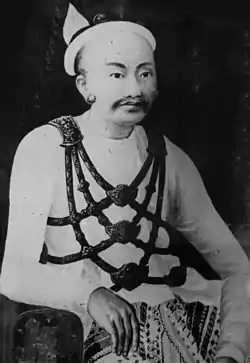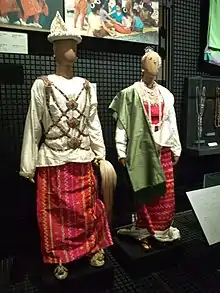Salwe
Salwe (Burmese: စလွယ်, [səlwɛ̀]) are issues for Burmese orders. A salwe is a shoulder-belt formed with metal chains, normally fashioned in gold or silver, which are fastened in four places, in shields or bosses, and worn over the shoulder like an officer's sash.[1]
- For the Polish chess player, see Gersz Salwe.

The Burmese monarchy used the salwe was purely secular, as it was used to recognize merit and service to the state.[1]
Etymology and origins
The Burmese language word salwe စလွယ် is a corruption of the Hindi term janeu (जनेऊ).[2] Janeu (also known as upanayana) in Hindi, refers to a sacred investiture or Brahminical cord found in the higher castes of Hindu society.[3]
It is of ancient Burmese origin.[1] The salwe is referenced in the Salwedin Sadan (Book of the Order), a Burmese text that states the number of salwe cords that members of each of the four Hindu varnas wore:
Usage

The number of strands or threads indicate rank in the order.[1] The salwe was worn as a symbol of high character, to maintain the purity of character of one's family or caste.[1]
During the Konbaung Dynasty, high-ranking ministers with immunity from various forms of execution (thetdawshay) also wore salwe of 18 strands.[1] The following is a list of Konbaung-era grades and corresponding number of salwe strands conferred:
| Grade | Number of Strands |
|---|---|
| King | 24 |
| Crown Prince | 21 |
| Shan Sawbwas, Princes of the Blood | 18 |
| Shan Myosas, other Royal Family Members | 15 |
| High-ranking Ministers (Mugyi, Matgyi) | 12 |
| Lower-ranking Ministers (Mulat, Matlat, Mu-nge, Matnge) | 3-9 |
Current usage
The following salwes are currently issued by the Government of Burma:
References
- Myanmar–English Dictionary. Myanmar Language Commission. 1993. ISBN 1-881265-47-1 http://sealang.net/burmese. Missing or empty
|title=(help) - Scott, James George; Hardiman, John Percy (1900). Gazetteer of Upper Burma and the Shan States. 2. Rangoon: Government of Burma.CS1 maint: ref=harv (link)
See also
| Wikimedia Commons has media related to Salwe. |
- Scott & Hardiman 1900, p. 134.
- MLC 1993.
- Scott & Hardiman 1900, p. 135.